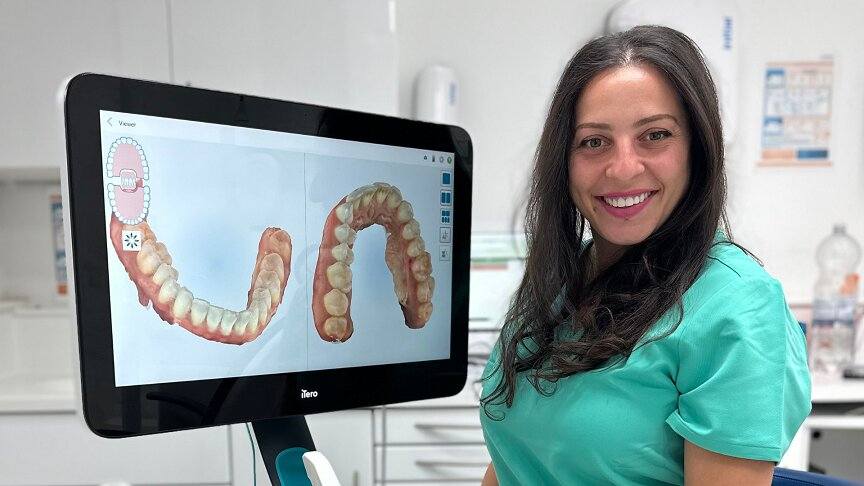Veneers are a transformative cosmetic dental treatment, offering patients a bright, confident smile in just a few visits. In London, they are among the most popular cosmetic dentistry options. But many patients ask: “How much of my natural tooth will be shaved for veneers?”
The answer varies depending on the type of veneer, your natural teeth, and the cosmetic goals. Traditional porcelain veneers usually require a small amount of enamel removal, typically 0.3–0.7mm, to ensure the veneer fits seamlessly and looks natural. However, modern veneer options, such as Lumineers and Emax veneers, often require little to no enamel shaving, allowing patients to preserve their natural tooth structure.
At Whites Dental London, we provide expert veneer treatments across two central London locations, ensuring patients receive precise, minimally invasive treatment while maintaining their oral health.
💡 At Whites Dental in London, our dentists provide a full range of treatments from our two Central London based veneers clinics.
Key Takeaway
- Traditional veneers remove 0.3–0.7mm of enamel, which is about the thickness of a fingernail.
- Minimal prep veneers like Lumineers or Emax can often be applied without any enamel removal.
- Preserving enamel helps reduce tooth sensitivity and maintains long-term dental health.
- The longevity of veneers depends on precise preparation, quality materials and consistent oral care.
- Consulting an experienced London cosmetic dentist ensures a balance between aesthetics and enamel preservation.
- Bite, tooth alignment and cosmetic goals influence how much tooth needs shaving
- Avoiding acidic or sugary foods post-treatment protects enamel margins from decay.
Why Enamel Removal Is Necessary For Veneers
Veneers are thin, custom-made layers of porcelain or composite that cover the front surface of your teeth. They are designed to enhance aesthetics, correct discoloration, or repair minor chips and gaps. Enamel shaving serves several key purposes:
- Natural Fit: Ensures veneers do not appear bulky.
- Proper Adhesion: Creates a surface for strong bonding.
- Smooth Alignment: Keeps veneers aligned with adjacent teeth.
💡 Although the idea of shaving enamel may sound intimidating, the process is minimally invasive and painless, thanks to local anaesthesia and modern dental tools. An experienced veneers dentist is able to safely remove the minimal amount required to provide an aesthetically pleasing smile outcome.
How Much Enamel Is Typically Removed
Traditional Porcelain Veneers
- Typical removal: 0.3–0.7mm
- Allows strong adhesion and natural appearance
- Thickness approximates a fingernail, so minimal structural impact occurs.
Emax Veneers
- High-strength lithium disilicate material.
- Ultra-thin veneers: 0.3–0.5mm
- Minimal enamel shaving required, preserving tooth structure
Lumineers / No-Prep Veneers
- Require little or no enamel shaving
- Thickness: 0.2–0.3mm.
- Often reversible if patient decides to remove veneers later
Composite Veneers
- Directly applied to the tooth surface
- Minimal enamel preparation or roughening
- Easy to repair if chipped or worn
Factors That Influence Tooth Shaving

Several variables determine how much tooth structure needs removal:
- Tooth Size And Shape – Crooked, crowded or worn teeth may need additional shaving to ensure alignment
- Veneer Material – Porcelain veneers generally require more enamel removal than Lumineers or Emax veneers.
- Cosmetic Goals – Dramatic color changes or reshaping teeth may require more enamel to achieve a natural look.
- Occlusion / Bite – Malocclusions may require extra preparation to ensure veneers do not interfere with your bite.
- Existing Dental Work – Crowns, fillings, or restorations may affect enamel removal and veneer placement.
Step-By-Step Tooth Preparation Process
Understanding the preparation process helps alleviate anxiety about enamel removal.
Step 1: Consultation
- Dentist evaluates teeth, bite, and cosmetic goals.
- Digital scans or X-rays measure enamel thickness and tooth health.
- Discussion of veneer options and enamel preservation strategies.
Step 2: Smile Design
- Digital mock-ups or temporary veneers demonstrate results.
- Dentist decides how much enamel to shave based on veneer type and desired outcome.
- Factors like colour change and bite correction influence shaving depth.
Step 3: Enamel Shaving
- Local anaesthetic ensures comfort.
- Dental burs remove precise amounts of enamel, usually 0.3–0.7mm for porcelain veneers.
- Minimal prep veneers like Lumineers often require no shaving.
Step 4: Impression / Scan
- Impressions or digital scans are taken for custom veneers.
- Ensures perfect fit, alignment, and aesthetics.
Step 5: Temporary Veneers (If Required)
- Protect teeth while permanent veneers are fabricated.
- Allow patients to preview the final result and adapt to changes.
Step 6: Bonding Permanent Veneers
- Veneers bonded using dental cement
- Dentist checks alignment, colour, and bite before curing.
- Ensures strong adhesion and long-lasting results.
Pros And Cons Of Tooth Shaving

Pros
- Creates a seamless, natural appearance.
- Allows strong adhesion for long-lasting results.
- Ensures veneers do not appear bulky or misaligned
Cons
- Enamel removal is irreversible for traditional veneers.
- Temporary sensitivity may occur after the procedure.
- Additional preparation may slightly increase cost.
Reducing Sensitivity After Tooth Shaving
- Use toothpaste for sensitive teeth
- Avoid extreme temperatures in food and drink.
- Rinse with fluoride mouthwash to strengthen enamel.
- Temporary veneers or protective bonding agents help shield newly exposed enamel.
Patient Experiences In London
Case 1: Porcelain Veneers For Discolouration
- Patient with stained teeth required 0.5mm enamel removal.
- Post-procedure, sensitivity lasted only a few days.
- Achieved bright, natural-looking results that improved self-confidence.
Case 2: Lumineers For Minor Gap Closure
- Patient opted for Lumineers with no enamel shaving.
- Painless procedure, reversible, and minimal recovery time.
- Smile transformation achieved without altering natural teeth.
Case 3: Emax Veneers For Chipped Teeth
- Emax veneers required 0.3mm preparation.
- High strength material protected teeth while offering ultra-thin, aesthetic results.
- Patient satisfied with minimal intervention and lasting durability.
Why Preserving Enamel Matters
- Protects natural tooth strength.
- Reduces risk of long-term sensitivity
- Maintains oral health and supports long-lasting veneers.
- Less invasive veneers are easier to maintain and require fewer replacements over time.
Oral Hygiene And Maintenance
- Brush twice daily with fluoride toothpaste.
- Floss carefully around veneer margins.
- Avoid chewing hard foods or ice.
- Limit sugary and acidic foods
- Attend 6-month dental check-ups;
- Consider a night guard for teeth grinding
- Rinse with water after meals to reduce plaque and acid exposure.
Types Of Veneers And Shaving Requirements
| Veneer Type | Thickness | Enamel Removal | Notes |
|---|---|---|---|
| Porcelain | 0.3–0.7mm | 0.3–0.7mm | Durable, classic choice for aesthetics |
| Emax | 0.3–0.5mm | 0.2–0.5mm | Ultra-thin, minimal prep, strong |
| Lumineers | 0.2–0.3mm | Often 0mm | No-prep, reversible, minimal intervention |
| Composite | 0.5–1mm | Minimal | Direct application, easy repair, less durable |
Common Misconceptions About Tooth Shaving
- All veneers require shaving – Lumineers and some Emax veneers may need none.
- Shaving damages teeth – Done correctly, enamel removal is safe.
- Veneers cause permanent sensitivity – usually temporary.
- Thicker veneers are always better – ultra-thin veneers often look more natural
- No-prep veneers are inferior – they preserve enamel and still provide excellent aesthetics;
Choosing The Right Veneer In London
- Consult experienced cosmetic dentists to assess enamel thickness and bite
- Balance aesthetic goals, durability, and enamel preservation when choosing veneer type.
- Consider long-term oral hygiene and maintenance.
FAQs – Tooth Shaving And Veneers
1. How painful is tooth shaving?
Minimal; local anaesthesia ensures comfort.
2. Will my teeth be weaker after enamel removal?
Small removal does not significantly weaken teeth.
3. Can no-prep veneers avoid shaving entirely?
Yes, Lumineers and some Emax veneers may require zero enamel removal.
4. How long does tooth preparation take?
Usually 1–2 hours, including evaluation, shaving, and impressions.
5. Do teeth need sensitivity treatment afterward?
Temporary sensitivity can occur; fluoride and careful care usually resolve it.
Why Choose Whites Dental In London
At Whites Dental, we offer all types of dental veneer treatments:
- Expert cosmetic dentists for precise veneer preparation
- High-quality materials for durable, ultra-thin veneers
- Custom smile design tailored to aesthetics and oral health.
- Convenient London locations: Waterloo (SE1) & Marble Arch (W2).
- Patient education on maintenance and long-term care
📍 Whites Dental Waterloo: 172 Blackfriars Rd, London SE1 8ER | 020 8616 0590
📍 Whites Dental Marble Arch: 52B Kendal St, St George’s Fields, London W2 2BP | 020 3576 2325
Conclusion
The amount of enamel removed for veneers depends on veneer type, tooth structure and cosmetic goals. Traditional porcelain veneers require 0.3–0.7mm, while modern Lumineers or Emax veneers often need little to no shaving. Consulting an experienced London cosmetic dentist, choosing the right veneer type and maintaining oral hygiene ensures a long-lasting, natural smile while preserving your tooth health.
